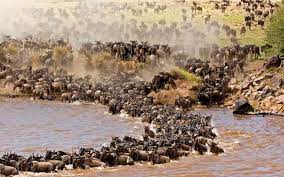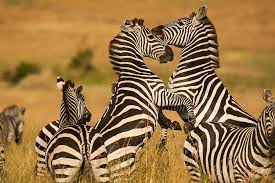The Great Annual Wildebeest Migration
The Great Annual Wildebeest Migration, is a natural phenomenon that takes place in East Africa, primarily in Tanzania and Kenya, but also extending into parts of Uganda. It is one of the most spectacular wildlife events on the planet, where millions of wildebeest, zebras, and gazelles move across the vast savannah in search of fresh water and grazing grounds.
The migration usually starts in the Serengeti in Tanzania, where the animals gather in huge herds, and then move northwards into the Masai Mara in Kenya. The exact timing and route of the migration vary from year to year, depending on the rainfall patterns, but typically the herds start moving towards the north in June or July and reach the Masai Mara around August or September. They then move back southwards towards the Serengeti around November or December.

The migration is a natural spectacle that attracts tourists from all over the world who come to witness the sheer volume of animals, as well as the predators that follow the herds, such as lions, leopards, and cheetahs. Visitors can witness the migration on game drives, hot air balloon rides, or walking safaris.
The Great Annual Wildebeest Migration is a unique and awe-inspiring natural event that is considered one of the seven wonders of Africa. It is truly a once-in-a-lifetime experience for wildlife enthusiasts and nature lovers alike.
The course of the Migration
The Great Annual Wildebeest Migration is a circular movement that occurs between Tanzania’s Serengeti National Park and Kenya’s Masai Mara National Reserve. It involves the movement of over 1.5 million wildebeest, along with hundreds of thousands of zebras and gazelles, in search of fresh grazing grounds and water.
The migration cycle begins in the southern Serengeti, where the wildebeest congregate in preparation for calving season in January and February. After giving birth, the herds start to move towards the north and the western corridor of the Serengeti, where they continue to graze and gather in large numbers.
Around June, the herds start to cross the Grumeti River, where they face danger from crocodiles and other predators. By July, the wildebeest reach the Masai Mara Reserve in Kenya, where they remain until around October. During this time, visitors to the Masai Mara can witness the incredible spectacle of thousands of wildebeest crossing the Mara River, often accompanied by predators such as lions and crocodiles.
After the rains start to return to the southern Serengeti in November, the herds begin their journey back south, crossing the Mara River again in the process. By December, they have returned to the southern Serengeti, where the cycle begins again with the calving season.
Overall, the migration is a complex and fascinating natural phenomenon, driven by the need for food, water, and survival. It is one of the greatest wildlife spectacles in the world and an unforgettable experience for visitors to East Africa.
The Wildebeest Migration With Mum And Dad Uganda Tours
The Wildebeest Migration With Mum And Dad Uganda Tours, While the Great Annual Wildebeest Migration primarily takes place in Tanzania and Kenya, Uganda safari tours also offer the opportunity to witness parts of the migration.
In particular, the western corridor of the Serengeti in Tanzania borders Uganda’s Queen Elizabeth National Park, which is home to a variety of wildlife, including elephants, lions, hippos, and over 600 species of birds. During the migration season, large numbers of wildebeest can also be seen in this area, as they make their way northwards towards the Masai Mara.
Additionally, Uganda’s Kidepo Valley National Park, located in the north of the country, is home to large herds of buffalo and elephants, as well as predators such as lions and cheetahs. Although the park is not directly on the migration route, it can still offer exciting game viewing opportunities during the migration season.
Overall, while Uganda may not be the primary destination for the Great Annual Wildebeest Migration, it can still provide unique opportunities to witness parts of the migration, as well as other incredible wildlife experiences.
Frequently asked questions Wildebeest Migration

- When is the best time to see the wildebeest migration? The migration typically takes place between July and October, but the exact timing can vary depending on rainfall and other factors.
- What other animals can be seen during the migration? In addition to wildebeest, the migration attracts a variety of other animals, including zebras, gazelles, and predators such as lions, cheetahs, and hyenas.
- How do I book a safari to see the migration? There are many tour operators that offer safaris to see the wildebeest migration. It’s important to do your research and choose a reputable operator with experienced guides and a strong commitment to conservation, however don’t look no further, the best tour and travel company arranging safaris in entire east Africa is Mum and Dad Uganda Tours With a 4×4 safari Land cruiser
- What should I pack for a safari to see the migration? You’ll want to pack light, breathable clothing that can protect you from the sun and insects. Good walking shoes, a hat, and sunglasses are also essential. Don’t forget to bring a camera and binoculars.
- Is it safe to go on safari during the migration? While there is always some degree of risk associated with any wildlife viewing activity, as long as you follow your guide’s instructions and respect the animals’ space, a safari during the migration is generally considered safe. wildebeest migration is regarded as one of the memorable experience
- Can I see the migration from both Tanzania and Kenya? Yes, the migration crosses the border between Tanzania and Kenya, so it’s possible to see it from both countries. Some tour operators offer safaris that cover both countries.
